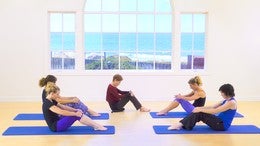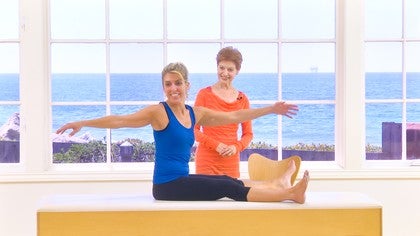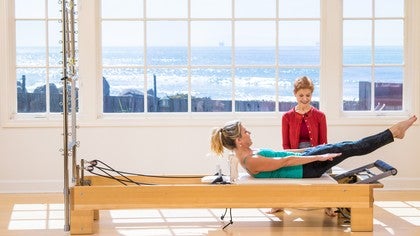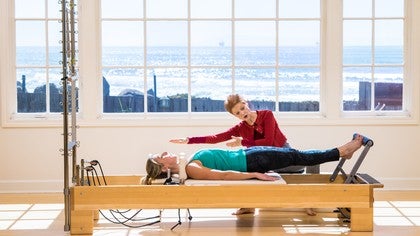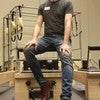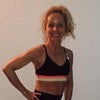Description
About This Video
Transcript
Read Full Transcript
Hello everyone. Um, we just finished a group class and I certainly hope that you'll observe that class practice the ideas that we presented in the class. And because of that now Kristy Cooper and I are going to take the results of what people learned in their class and apply it to two of the exercises that she chooses and what was I like to test out the saw and also rollover. Okay, good. So A, we'll apply the learning to these two designs. All right, so let me just observe you. Which one do you want me to do first? Um, this off. What'd you do at your normal way before the class so that I could just observe that and then we'll play with those cueings from the class. Okay, thank you. Okay, so as you are doing that now, the pieces that we did were to find neutral, to play with asymmetry and to play with gravity and ground reaction force. So let's do that now.
This time what I'd like you to do is as you start lifting your arms, think about the contact points here and your pelvis. Simply pushing those to those four contact weights into the table. Just as you lift your arms there and now don't do that and feel the difference. [inaudible] it's more isolated. I feel that through here. Yes. Do it one more time. Both ways.
Okay. So to begin, will you start again with contact point GRF GRF as you get here, go co-head. Yeah. Release the contact points slightly to push off again to rotate your body toward the pushing off this side a little bit more. There you go there. How does it feel like I'm over there now? Far. Okay, good. And come on back and do the other side. GRF GRF contact points being the heels being the issue of tuberosities.
Now don't use the contact points and show people the difference. Please. It feels like you hit a stop. Yeah, yeah. And rage, right? Yeah, yeah, yeah. So the GRF gaps, the joints and it lengthens you. So therefore your rotation is greater and you're far less likely to keep perpetuating one sidedness so let's do it one more time. GRF softening the GRS contact points again to rotate.
Beautiful. And GRF again. Very nice. Very nice. Big Difference. Okay, so now let's go one again. Contact points, contact points. Now, right here, think about your effing again off the issue to grasses. So you hinge through your hip and you go further forward. Now you round and beautiful and push off the leg to come back. You can't see her expression as well as I can, but it's really fun.
Cheer, cheer, have lengthen long there and now flex. Beautiful. And so what I want to draw your attention to, even before you do the other side, is that when you were first doing this, as soon as you would start to bend forward, this would flex like you'd run out of room. So your head was trying to make up for it somehow. This time I see you, he long gate and then everything rounds instead of just the upper thorax. Try that again.
Good. Yeah. Good. That's great. And so now do it the old way once. This is the research part of my work. Can you feel you're going back into yourself? Yeah, the trunk is [inaudible] all the way. Yeah.
It's not changed too much in any way. Good. No. Very nice. I just more connected. Good. Okay. Number one. And now number two, let's see it the way you did it so beautifully. Thank you. So no, shall we a play. So start with first of all, um, with your legs straight down and relax on the table and feel, if you just put your heels into the table and push into flection, it elongates your body.
Go ahead and now use your hands to really push down, engage that ground reaction for us to bring the legs. What's happening? Lighter, lighter, longer. [inaudible] troll the fall with the hands, sir. Good, good, good, good, good. Yeah. And now just for fun, we'll start the same way. But as you start to come back, play with your hands ever so slightly on my newt motions of asymmetry as you start to
How we've made ourselves, or an Andy exercise, we've made ourselves asymmetrical. This just started to negotiate those asymmetries. And when they get movement through loading and release pressure and no pressure, they start to change. So we're actually improving from the oscillation. So that's, yeah. So now let's continue.
The advancing of these ideas play with the oscillation on the way up. Very nice. She's making sounds, Huh? Hmm. Those are sounds of someone discovering something about themselves. Very exciting.
I see something's changing.
That's great. Really Great. I mean, even now I feel Martin even on my system. How do you feel standing? Yeah, steady way. Marty better than normal. So would you tell me if you can, what was the experience that made it close to your emotion? Close to your heart, close to your whatever it is. It said, I have to do that. What? What was that? It's the balance.
That's the piece. To me, the bottom line we all have to remember is we have choice. And when we don't have choice, we need the question. You need to go [inaudible].
Then I just felt my back open up while doing the work. I love politeness. I just felt that I made the choice to slow down the temple. Oh, that worked for me. Right? Yeah, and at home you all have this opportunity. You are your own best teacher. You are your own best teacher.
Thank you so much for your interest and joining into Aston Kinetics.
Mindful Movement - Playlist 2: Applying Aston Kinetics
Comments

i happen to agree with you and Robert. I will create a place for them that is clearly marked. I may even make a program that is specifically Aston Kinetics as it relates to Pilates. Judith was here last weekend and she rocked my Pilates notions again! Look for new content from her in about 6 weeks (maybe sooner)! Thank you both for the great suggestion!
You need to be a subscriber to post a comment.
Please Log In or Create an Account to start your free trial.
